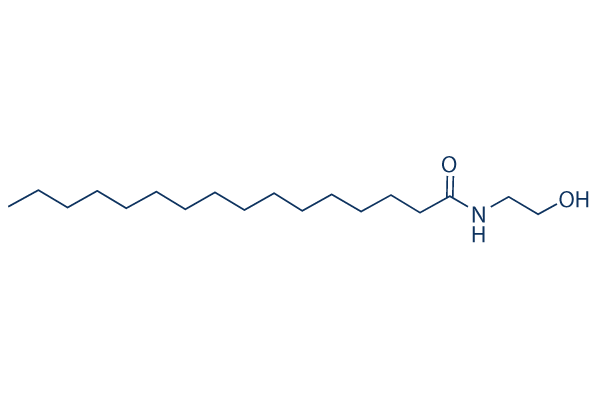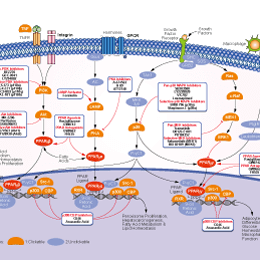
- Bioactive Compounds
- By Signaling Pathways
- PI3K/Akt/mTOR
- Epigenetics
- Methylation
- Immunology & Inflammation
- Protein Tyrosine Kinase
- Angiogenesis
- Apoptosis
- Autophagy
- ER stress & UPR
- JAK/STAT
- MAPK
- Cytoskeletal Signaling
- Cell Cycle
- TGF-beta/Smad
- DNA Damage/DNA Repair
- Compound Libraries
- Popular Compound Libraries
- Customize Library
- Clinical and FDA-approved Related
- Bioactive Compound Libraries
- Inhibitor Related
- Natural Product Related
- Metabolism Related
- Cell Death Related
- By Signaling Pathway
- By Disease
- Anti-infection and Antiviral Related
- Neuronal and Immunology Related
- Fragment and Covalent Related
- FDA-approved Drug Library
- FDA-approved & Passed Phase I Drug Library
- Preclinical/Clinical Compound Library
- Bioactive Compound Library-I
- Bioactive Compound Library-Ⅱ
- Kinase Inhibitor Library
- Express-Pick Library
- Natural Product Library
- Human Endogenous Metabolite Compound Library
- Alkaloid Compound LibraryNew
- Angiogenesis Related compound Library
- Anti-Aging Compound Library
- Anti-alzheimer Disease Compound Library
- Antibiotics compound Library
- Anti-cancer Compound Library
- Anti-cancer Compound Library-Ⅱ
- Anti-cancer Metabolism Compound Library
- Anti-Cardiovascular Disease Compound Library
- Anti-diabetic Compound Library
- Anti-infection Compound Library
- Antioxidant Compound Library
- Anti-parasitic Compound Library
- Antiviral Compound Library
- Apoptosis Compound Library
- Autophagy Compound Library
- Calcium Channel Blocker LibraryNew
- Cambridge Cancer Compound Library
- Carbohydrate Metabolism Compound LibraryNew
- Cell Cycle compound library
- CNS-Penetrant Compound Library
- Covalent Inhibitor Library
- Cytokine Inhibitor LibraryNew
- Cytoskeletal Signaling Pathway Compound Library
- DNA Damage/DNA Repair compound Library
- Drug-like Compound Library
- Endoplasmic Reticulum Stress Compound Library
- Epigenetics Compound Library
- Exosome Secretion Related Compound LibraryNew
- FDA-approved Anticancer Drug LibraryNew
- Ferroptosis Compound Library
- Flavonoid Compound Library
- Fragment Library
- Glutamine Metabolism Compound Library
- Glycolysis Compound Library
- GPCR Compound Library
- Gut Microbial Metabolite Library
- HIF-1 Signaling Pathway Compound Library
- Highly Selective Inhibitor Library
- Histone modification compound library
- HTS Library for Drug Discovery
- Human Hormone Related Compound LibraryNew
- Human Transcription Factor Compound LibraryNew
- Immunology/Inflammation Compound Library
- Inhibitor Library
- Ion Channel Ligand Library
- JAK/STAT compound library
- Lipid Metabolism Compound LibraryNew
- Macrocyclic Compound Library
- MAPK Inhibitor Library
- Medicine Food Homology Compound Library
- Metabolism Compound Library
- Methylation Compound Library
- Mouse Metabolite Compound LibraryNew
- Natural Organic Compound Library
- Neuronal Signaling Compound Library
- NF-κB Signaling Compound Library
- Nucleoside Analogue Library
- Obesity Compound Library
- Oxidative Stress Compound LibraryNew
- Plant Extract Library
- Phenotypic Screening Library
- PI3K/Akt Inhibitor Library
- Protease Inhibitor Library
- Protein-protein Interaction Inhibitor Library
- Pyroptosis Compound Library
- Small Molecule Immuno-Oncology Compound Library
- Mitochondria-Targeted Compound LibraryNew
- Stem Cell Differentiation Compound LibraryNew
- Stem Cell Signaling Compound Library
- Natural Phenol Compound LibraryNew
- Natural Terpenoid Compound LibraryNew
- TGF-beta/Smad compound library
- Traditional Chinese Medicine Library
- Tyrosine Kinase Inhibitor Library
- Ubiquitination Compound Library
-
Cherry Picking
You can personalize your library with chemicals from within Selleck's inventory. Build the right library for your research endeavors by choosing from compounds in all of our available libraries.
Please contact us at [email protected] to customize your library.
You could select:
- Antibodies
- Bioreagents
- qPCR
- 2x SYBR Green qPCR Master Mix
- 2x SYBR Green qPCR Master Mix(Low ROX)
- 2x SYBR Green qPCR Master Mix(High ROX)
- Protein Assay
- Protein A/G Magnetic Beads for IP
- Anti-Flag magnetic beads
- Anti-Flag Affinity Gel
- Anti-Myc magnetic beads
- Anti-HA magnetic beads
- Magnetic Separator
- Poly DYKDDDDK Tag Peptide lyophilized powder
- Protease Inhibitor Cocktail
- Protease Inhibitor Cocktail (EDTA-Free, 100X in DMSO)
- Phosphatase Inhibitor Cocktail (2 Tubes, 100X)
- Cell Biology
- Cell Counting Kit-8 (CCK-8)
- Animal Experiment
- Mouse Direct PCR Kit (For Genotyping)
- New Products
- Contact Us
Palmitoylethanolamide
Synonyms: Palmidrol|N-palmitoylethanolamine
Palmitoylethanolamide (PEA, Palmidrol, N-palmitoylethanolamine) is an endogenous fatty acid amide and selectively activates PPAR-α in vitro with an EC50 value of 3.1±0.4 μM.

Palmitoylethanolamide Chemical Structure
CAS No. 544-31-0
Purity & Quality Control
Batch:
Purity:
99.93%
99.93
Palmitoylethanolamide Related Products
| Related Targets | PPARα PPARβ/δ PPARγ PPARδ | Click to Expand |
|---|---|---|
| Related Products | T0070907 GW9662 GW6471 WY-14643 (Pirinixic Acid) GSK3787 GW0742 AZ6102 Astaxanthin Eupatilin GSK0660 Oroxin A Harmine Lanifibranor (IVA-337) DG172 dihydrochloride Glabridin Ciprofibrate Clofibric Acid Alpinetin Elafibranor Daidzein Gypenoside XLIX | Click to Expand |
| Related Compound Libraries | Metabolism Compound Library Anti-cancer Metabolism Compound Library Glutamine Metabolism Compound Library Carbohydrate Metabolism Compound Library Lipid Metabolism Compound Library | Click to Expand |
Signaling Pathway
Biological Activity
| Description | Palmitoylethanolamide (PEA, Palmidrol, N-palmitoylethanolamine) is an endogenous fatty acid amide and selectively activates PPAR-α in vitro with an EC50 value of 3.1±0.4 μM. | ||
|---|---|---|---|
| Targets |
|
| In vitro | ||||
| In vitro | PEA protects cultured mouse cerebellar granule cells from glutamate toxicity and enhances microglial cell motility. In the mitochondrial fraction from cells stimulated with PEA, steroidogenic acute regulatory protein (StAR) and cytochrome P450 enzyme(P450scc) expression increases, both comprising proteins considered to be involved in crucial steps of neurosteroid formation. Moreover, PEA shows a protective effect, reducing malondialdehyde formation in cells treated with L-buthionine-(S,R)-sulfoximine, a glutathione depletor and the effect of PEA is partially inhibited by finasteride, a 5a-reductase inhibitor[2]. | |||
|---|---|---|---|---|
| Cell Research | Cell lines | Rat C6 glioma cells | ||
| Concentrations | 10 μM | |||
| Incubation Time | 24 h | |||
| Method | C6 glioma cells (300 000⁄P60 dish) or astrocyte primary culture are incubated in serum-free DMEM at 37℃ for at least 24 h before each experiment. Then, cells are treated with PEA (10 μM) for 24 h in serum-free medium, in the presence and absence of GW6471 (10 μM) added 30 min before ethanolamide treatment. The concentration of PEA is chosen on the basis of preliminary experiments, assessing drug efficacy without modifi-cation of cell viability. PEA and GW6471 are first dissolved in absolute ethanol and then diluted with DMEM. The final ethanol concentration was< 0.5%. Mitochondrial protein extracts from C6 or astrocytes are obtained. Alternatively after 24 h of starvation in serum-free DMEM, C6 cells are treated with FIN (100 nM). After 30 min, PEA (10 μM) and⁄or ALLO (3 μM) is added and, 30 min later, are stimulated with BSO (10 mM). After 18 h, MDA is evaluated. In this set of experiments, FIN and⁄or PEA are dissolved in dimethylsulphoxide (DMSO) and then diluted with DMEM (0.1% final DMSO concentration). | |||
| In Vivo | ||
| In vivo | PEA attenuates inflammation in wild-type mice but has no effect in mice deficient in PPAR-α. PEA has been shown to inhibit peripheral inflammation and mast-cell degranulation as well as to exert neuroprotective and antinociceptive effects in rats and mice. These actions are accompanied by changes in nitric oxide production, neutrophil influx, and expression of proinflammatory proteins such as inducible nitric oxide synthase and cyclooxygenase-2[1]. In addition to its known anti-inflammatory activity, PEA regulates many pathophysiological processes, including pain perception, convulsions, and neurotoxicity. In the central nervous system (CNS), where PEA is present at detectable levels, its concentrations significantly increase under pathological conditions, such as excitotoxicity, brain ischaemia and neuroinflammation[2]. | |
|---|---|---|
| Animal Research | Animal Models | C57BL6 mice, male C57BL6 PPAR-α-/- mice |
| Dosages | 10 mg/kg | |
| Administration | i.p | |
| NCT Number | Recruitment | Conditions | Sponsor/Collaborators | Start Date | Phases |
|---|---|---|---|---|---|
| NCT06040164 | Not yet recruiting | PreDiabetes|Diabetes Mellitus Type 2|Obesity|Oral Dysbiosis|Mouth Disease |
Fundación Pública Andaluza para la Investigación de Málaga en Biomedicina y Salud |
October 1 2023 | -- |
| NCT05849792 | Completed | Exercise|Physical Fitness|Depression|Adult ALL|Psychological |
University of Cadiz|Consejería de Salud y Familia (Junta de Andalucía)|Institute of Biomedical research and innovation of Cádiz (INIBICA) |
September 1 2019 | Not Applicable |
| NCT03564379 | Completed | Healthy |
Janssen Research & Development LLC |
June 12 2018 | Phase 1 |
| NCT01092845 | Completed | Healthy|Sleep |
Pfizer |
April 2010 | Phase 1 |
| NCT01370720 | Unknown status | Irritable Bowel Syndrome |
MARIA CRISTINA COMELLI|CM&D Pharma Limited |
February 2010 | Phase 2 |
Chemical Information & Solubility
| Molecular Weight | 299.49 | Formula | C18H37NO2 |
| CAS No. | 544-31-0 | SDF | Download Palmitoylethanolamide SDF |
| Smiles | CCCCCCCCCCCCCCCC(=O)NCCO | ||
| Storage (From the date of receipt) | |||
|
In vitro |
Ethanol : 59 mg/mL DMSO : 5 mg/mL ( (16.69 mM) Moisture-absorbing DMSO reduces solubility. Please use fresh DMSO.) Water : Insoluble |
Molecular Weight Calculator |
|
In vivo Add solvents to the product individually and in order. |
In vivo Formulation Calculator |
||||
Preparing Stock Solutions
Molarity Calculator
In vivo Formulation Calculator (Clear solution)
Step 1: Enter information below (Recommended: An additional animal making an allowance for loss during the experiment)
mg/kg
g
μL
Step 2: Enter the in vivo formulation (This is only the calculator, not formulation. Please contact us first if there is no in vivo formulation at the solubility Section.)
% DMSO
%
% Tween 80
% ddH2O
%DMSO
%
Calculation results:
Working concentration: mg/ml;
Method for preparing DMSO master liquid: mg drug pre-dissolved in μL DMSO ( Master liquid concentration mg/mL, Please contact us first if the concentration exceeds the DMSO solubility of the batch of drug. )
Method for preparing in vivo formulation: Take μL DMSO master liquid, next addμL PEG300, mix and clarify, next addμL Tween 80, mix and clarify, next add μL ddH2O, mix and clarify.
Method for preparing in vivo formulation: Take μL DMSO master liquid, next add μL Corn oil, mix and clarify.
Note: 1. Please make sure the liquid is clear before adding the next solvent.
2. Be sure to add the solvent(s) in order. You must ensure that the solution obtained, in the previous addition, is a clear solution before proceeding to add the next solvent. Physical methods such
as vortex, ultrasound or hot water bath can be used to aid dissolving.
Tech Support
Answers to questions you may have can be found in the inhibitor handling instructions. Topics include how to prepare stock solutions, how to store inhibitors, and issues that need special attention for cell-based assays and animal experiments.
Tel: +1-832-582-8158 Ext:3
If you have any other enquiries, please leave a message.
* Indicates a Required Field
Tags: buy Palmitoylethanolamide | Palmitoylethanolamide supplier | purchase Palmitoylethanolamide | Palmitoylethanolamide cost | Palmitoylethanolamide manufacturer | order Palmitoylethanolamide | Palmitoylethanolamide distributor







































